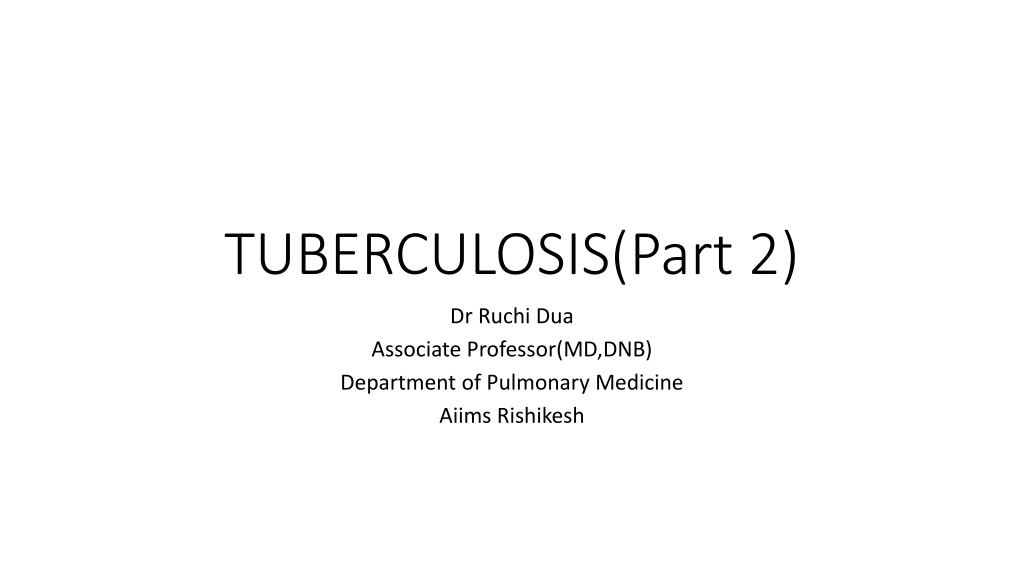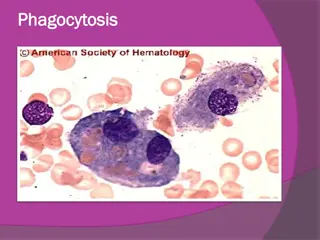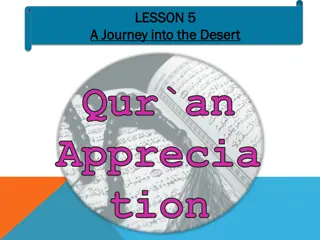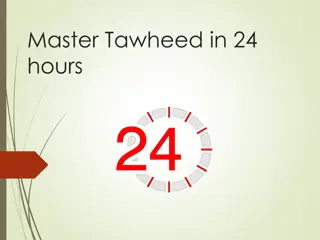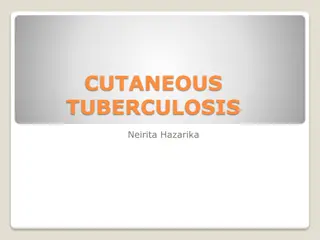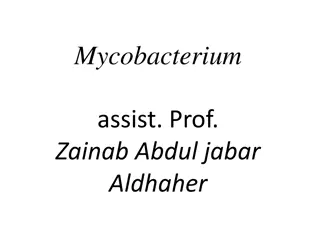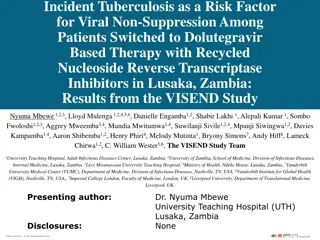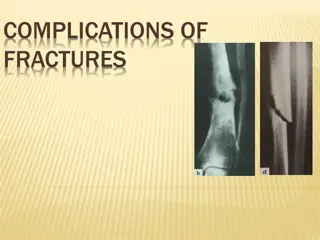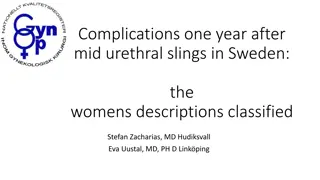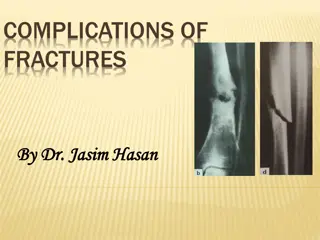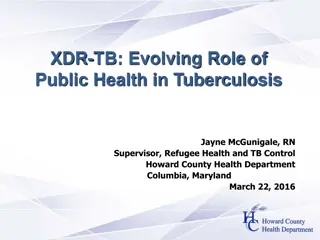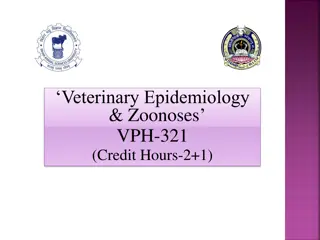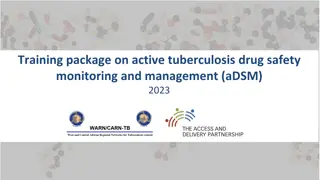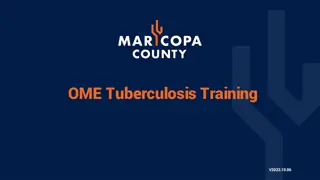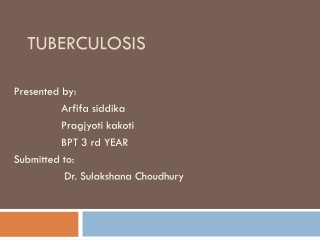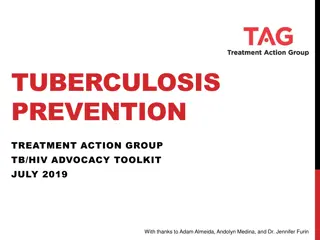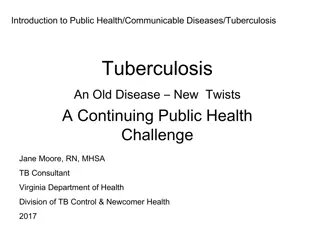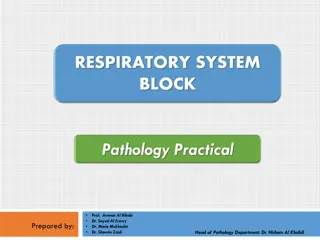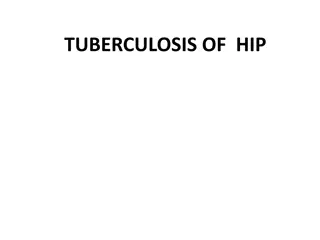Complications and Presentations of Tuberculosis: A Detailed Overview by Dr. Ruchi Dua
This presentation by Dr. Ruchi Dua, Associate Professor at Aiims Rishikesh, delves into the complications of tuberculosis including local and systemic effects, as well as various presentations of extrapulmonary TB. Topics covered include common complications like respiratory failure, pleural effusion, and systemic shock, alongside presentations of TB in different body systems such as skeletal, CNS, and abdominal involvement. The slides also touch upon drug-resistant tuberculosis, DOTS, RNTCP, and highlight the challenges in diagnosing extrapulmonary TB.
Download Presentation

Please find below an Image/Link to download the presentation.
The content on the website is provided AS IS for your information and personal use only. It may not be sold, licensed, or shared on other websites without obtaining consent from the author. Download presentation by click this link. If you encounter any issues during the download, it is possible that the publisher has removed the file from their server.
E N D
Presentation Transcript
TUBERCULOSIS(Part 2) Dr Ruchi Dua Associate Professor(MD,DNB) Department of Pulmonary Medicine Aiims Rishikesh
OBJECTIVES What are complications of tuberculosis? What are various presentations of EPTB? Drug resistant tuberculosis DOTS & RNTCP
COMPLICATIONS COMPLICATIONS Local- ARDS/respiratory failure Bronchiectasis/PTOAD aspergilloma haemoptysis (symp ) Pleural -Empyema/pneumo Extensive lung destruction Rt middle lobe syndrome Scar ca
Systemic- shock amyloidosis disseminated tb-(laryngeal tb) Cor-pulmonale
EPTB Common sites:LN,PE Any site Diagnosis:more difficult
LN TB LN-site painless enlargement ,systemic symptoms<50% Matting Sinus/fistula FNAC/Bx/NAAT/smear/culture
Pleural Effusion Pain/dyspnea/cough Fever/dec appetite Radiology Pleural fluid analysis
SKELETAL TB Site Pain/joint swelling/dec range of motion. Draining sinuses and abscesses Systemic symptoms Radiographic changes m/b nonspecific
CNS TB Tuberculous meningitis(MC), intracranial tuberculomas, , cranial nerve palsies and communicating hydrocephalus , cranial vasculitis may lead to focal neurologic deficits. Malaise, headache, fever, or personality change,A/S,seizures/focal defects CSF lymphocytic,increased protein,ADA,CB NAAT
Kochs abdomen Site-gut/peritoneum/LN pain,nausea/vomitting altered bowel habbits Distension Diagnosis:ascetic fluid analysis/LN sampling/radiology
Miliary Fever/dec appetite/wt loss/vague-elderly Haematogenous Fulminant disease -septic shock, ARDS,MOF CXR/Liver/spleen BX/BM Haematological-anaemia(NCNC),hyponatremia
PRESENTATION(Extra-Pulmonary) Genitourinary-infertility, urinary difficulties CVS-pericarditis(pain/dyspnea)
CLINICAL CLUES-EPTB Ascites -lymphocyte predominance and negative bacterial cultures Chronic lymphadenopathy (especially cervical) CSF -lymphocytic pleocytosis / elevated protein /low glucose Pleural effusion -Exudative / lymphocyte predominance/negative bacterial cultures Joint inflammation (monoarticular) with negative bacterial cultures Persistent sterile pyuria Unexplained pericardial effusion, constrictive pericarditis, or pericardial calcification/Vertebral osteomyelitis involving the thoracic spine
Principles of chemotherapy Variable bacilli population:rapid growers,slow growers,dormant Longer duration 2 phases of treatment Need for multiple drugs to treat(spontaneous resistance)
TREATMENT REGIMENS Type of TB case Intensive Phase Continuation Phase New(CAT 1) 2RHEZ 4RHE Retreatment(CAT 2) 2SHREZ/1RHEZ Intermittent regimens are being changed to daily regimens under RNTCP in India 5RHE R;rifampicin,H:isoniazid,E:ethambutal,Z:pyrazinamide,S:streptomyci n
New case:CAT 1 Smear positive Smear negative EPTB Retreatment:CAT 2 Relapse Defaulter failure
CAT 4 :MDR CAT 5:XDR Definitions MDR:R and H XDR:R and H,any FQ,any injectables(kanamycin,amikacin,capreomycin) Primary & acquired resistance Mono/poly drug resistance:DRTB
Drug Resistance:Magnitude 3% Primary 12% Acquired XDR 4-20% of MDR
Dx in drug resistant Tb MDR-TB: Rapid Molecular Test ( LPA/ CB-NAAT) Liquid Culture & DST Solid Culture & DST XDR-TB: Liquid Culture & DST Solid Culture & DST LPA(Genotypic methods)
Changed to daily
Grouping of antiTb drugs(2017 ,RNTCP guidelines) FQ Levo/moxi/gati Injectable agents K/A/C Other second line drugs Etio/prothio/cycloserine/linezolid Add on drugs D1:Z/E/H high dose,D2:Bedaquiline/delaminid D3:PAS,Amoxy-clav,Meropenem,imipenem cilastatin
DR TB:Principles of Treatment MDR:4 second line drugs /not used XDR:7 drugs Duration:24(MDR),36(XDR) DOTS plus previously
Second line drugs Treatment longer Toxic Expensive more Stress:emergence rather than treatment of DRTb
Newer ATT Bedaquiline Delaminid protaminid
MCQ A pt on ATT C/O burning soles A pt on ATT C/O loss of appetite & vomittings A pt on ATT C/O dec vision
Advantages Directly observed Standardised treatment Free of cost
TB & HIV Increased chances of reactivation/relapse Atypical presentations Higher ADR/drug interactions Priorty to treat Tb first and then ART
TB & DM Higher risk Glycemic control must for cure Higher chances of ADR
